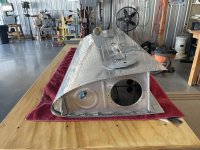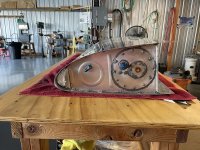Scott Hersha
Well Known Member
I’m just about ready to fly my new RV6 for the first time, and yesterday, I found a fuel leak. Fuel has been in my tanks for about two weeks and used for testing with no leaks until yesterday. It’s a very slow leak - evaporates before it can drip to the floor. Just a little blue line around a rivet on the inboard rib flange on the bottom. I didn’t build the wings, or the tanks, but I did remove the tanks when I bought the kit to replace the cork gaskets under the fuel level floats. I re-installed the floats with proseal and pressure tested the tanks with balloons - successfully. I plan to remove the tank for easier access and remove the large access panel to make the repair. The leak is on a rivet in the inboard tank rib where I installed a countersunk plate nut for the wing root fairing. This RV6 didn’t have much of a flange for platenut installation, and the platenuts are sitting close to the web of that inboard rib. The platenut rivets are along the same line as the rivets securing the rib to the tank skin. I suspect that there isn’t much proseal on the inside of that inboard rib to tank skin area, and I plan to clean it up and proseal a fillet along that line on the inside.
My question is about cure time. It’s pretty warm here in Cincinnati, so it should cure fairly quickly. I’ve read online that full cure takes 3 days at 70* F, but how long should I wait before putting fuel in the tank? Also, I’ve read about using chem seal CS 3600 over the poly sulfide (proseal). Anyone have experience with that? Any suggestions are appreciated.
I’m kind of anxious to fly this thing - then this……. My inspection is tomorrow.
My question is about cure time. It’s pretty warm here in Cincinnati, so it should cure fairly quickly. I’ve read online that full cure takes 3 days at 70* F, but how long should I wait before putting fuel in the tank? Also, I’ve read about using chem seal CS 3600 over the poly sulfide (proseal). Anyone have experience with that? Any suggestions are appreciated.
I’m kind of anxious to fly this thing - then this……. My inspection is tomorrow.






